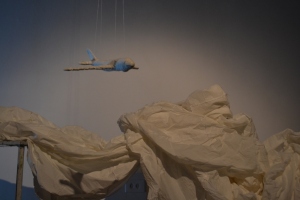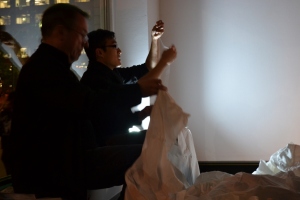Earlier tonight I attended the opening of Andrew McPhail‘s installation CRYBABY at the Untitled Art Society’s Satellite Gallery. This exhibition is part of Mountain Standard Time – the seventh biennial performative art festival, known more colloquially as M:ST 7 which begins this weekend in both Lethbridge and Calgary.
It is a quiet installation, with subdued lighting. This show contrasted quite starkly with the opening held at the same time at Avalanche! Institute of Contemporary Art in their space directly below UAS.
At Avalanche! Shawn Mankowske‘s and Palmer Olson‘s two-person exhibition momento maury showed bright colours, abstract shapes along with a tip of the hat and awareness of op-art and formalist abstraction from the 1960s and 1970s. It is an odd combination to see in Calgary. Formalist abstraction has never gained significant traction and had very little impact in the city during its heyday (or since). I could probably write lots about this odd disconnect as it is something that has fascinated me for quite some time.
* * *
As stated above Andrew McPhail’s CRYBABY installation at UAS is subdued and accentuates the sublime nature of the work – especially at night when I attended. The absence of natural light lends itself well to the exhibition and the somewhat theatrical lighting made it more dramatic than it probably otherwise would be during daylight hours, when the gallery receives natural light.
This is an ongoing installation begun in 2010 that has been installed previously at two separate locations – Union Gallery at Queen`s University in Kingston (2011) and at TH&B at 270 Sherman (the former Imperial Cotton Mill) in Hamilton (2012).
Briefly this work originated as a result of an experience the artist had while making a trans-Atlantic flight. His seatmate, whom he did not know, suffered a heart-attack while en route and passed away. This work came as a result of this experience. It is a memorial of sorts to this unknown person and the often overwhelming nature of grief.
The work itself is made up of thousands of Kleenex tissues that are individually stitched together. At the opening and various times throughout the exhibition the performative component of the show as part of M:ST 7 has the artist stitching tissues together and engaging viewers in dialogue with issues surrounding the work.
This situation that led to this work is a sad circumstance. However, it is something we all can relate to.
We all will encounter death, sadness and loss at some point in our lives. It may be someone we know, a relative or someone we have loved. It could be a casual acquaintance we once knew. It could be a random circumstance such as what happened to McPhail. Or in a similar way like myself when I was bicycling home yesterday and chanced upon a policeman calling for an ambulance (I assume) while he stood near a fellow who appeared to have fallen, and was lying motionless on the concrete beside an apartment building, with what appeared to be blood in the area of his head. Who knows how long he was there. For that matter, we could even ponder our own failing health or those family members that we are closest to.
It is these together – the all too frequent points in our lives, where we are reminded of our own frailties and the transitory nature of life itself.
Plato wrote a great dialogue in his middle period called Phaedo. It is told from the perspective of one of Socrate‘s students – Phaedo of Elis. Here, Plato using the voice of Phaedo and Socrates’ associates talks about the events leading up to the death of Socrates. He then goes on to present four arguments in favour of the immortality of the soul and the afterlife:
- The Cyclical Argument, or Opposites Argument;
- The Theory of Recollection;
- The Affinity Argument; and;
- The Argument of the Form of Life, or The Final Argument.
There has been much discussion over the centuries about how we deal with the issue of grief – and death. It is something that we must all come to terms with in our own way. However, this is an important discussion to have, as it has deep resonance with all.
This issue that Plato discussed and related questions are some of the fundamental questions of all religious thought and philosophy. These are questions such as:
- What happens when our mortal life ends?
- What is the meaning of life?
- What purpose do we have? and;
- Why do we live?
* * *
This all brings me back to the Avalanche! show in a circuitous and very odd, but related way.
The choice of title momento maury for Mankowske‘s and Olson‘s exhibition riffs off the centuries old Latin phrase momento mori which roughly translated means “remember (you have to) die”. This phrase is interesting as it carries a lot of philosophical, art historical, musical and religious baggage and is frequently referenced throughout the centuries.
The concept of momento mori comes from the Vulgate Latin rendering of Ecclesiasticus 7:40 which reads “in omnibus operibus tuis memorare novissima tua, et in aeternum non peccabis” or as it is translated “in all thy works be mindful of thy last end and thou wilt never sin.”
As an aside, this Latin phrase in the exhibition context with the title, is also mildly humourous – which is probably the intent.
This is especially so, when one reflects further upon the theories of Clement Greenberg and formalist abstraction which their paintings reference.
* * *
Returning once again to McPhail’s work we see that he also draws from the concept of momento mori. Even the materials used – Kleenex tissues – also talk about the ephemeral nature of life.
That is what good art should do – give the viewer something to think about.
Put the UAS show in your list of things to view. While there, make a slight detour, go down the stairs and visit Avalanche! as well.

